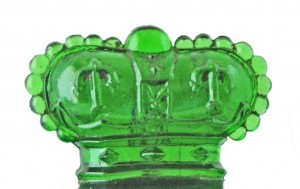How did a mostly illiterate population, living in a world where steam powered engines were the latest technological wonder, learn what existed beyond their neighborhood? How did businesses promote their products and expand their markets if there was no electricity to create spiffy commercials for 86” televisions and 6” smart phones? And if there were no videos to showcase the talent of artists, how was culture spread throughout the world?
The simple answer is international exhibitions. These exhibitions brought the latest advances in science, industry, education and the arts to millions of visitors. For a brief span of four to six months, the general public was shown the latest and greatest inventions; scientists and educators compared notes with colleagues from every part of the globe; and artists gave working demonstrations of their craft to spellbound crowds.
Society at all levels came to the international exhibitions and world fairs by the millions. They came within touching distance of the huge steam and combustion engines which would power railway engines and machinery in the textile mills. They came to be influenced in how to best decorate their homes with objet d’art and furnishings that were on display (and for sale!) from international artists whose culture was vastly different from their own. Society also came to see how a simple flower could be rendered into a mysterious and alluring perfume.
Special government offices were created to assist business owners in the organization and transportation of displays. For the 1873 Vienna Exhibition, the United States Congress approved $200,000 for American exhibitor support. American exhibitors had only to pay shipping costs for their items to reach ports in New York or Boston. The government would then transport the displays to the exhibition buildings, at no further expense to the exhibitor. American companies participated in record numbers, numbers which far exceeded their allotted space. Not wanting to omit items, the Americans quickly constructed an additional 2,500 square meter courtyard.
Each exhibition was a separate entity, with the host deciding the number and style of awards given — which explains the many problems of comparing medals and awards among exhibitions. For the major exhibitions, 30,000 medals could be awarded for a six month event. All medals were equal in rank and value at Vienna’s 1873 Weltasstellung International Exhibition. Medals were awarded for Merit; Progress; Good Taste; and Fine Art. The United States Centennial International Exhibition, Philadelphia 1876, awarded only medals made from bronze. Melbourne’s 1888 Centennial International Exhibition reclassified their awards midstream. The First Order of Merit medal became the Gold medal; the Second Order of Merit became the Silver medal and the Third Order of Merit became the Bronze medal.
Prize medals were an important part of the exhibition experience. An award was a tangible and prestigious advantage in advertising. Companies would announce their latest gold medal or Grand Prix diploma in print advertisements. The Crown Perfumery Company would periodically update their medal count in advertisements. In a March 4th, 1884 ad, the company had 7 prize medals. Six years later, the count was at 12 and then it reached 17 exhibition awards in 1897. These awards were given for Crown’s assortment of superior perfumes and essences as well as for their individual perfumes, lavender water, buffalo horn combs and toilet soaps.
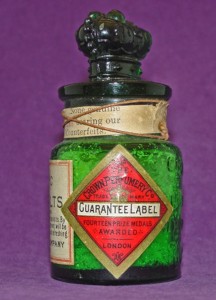
.
Labels were attached to perfume bottles and medals were copied onto stationery.

Courtesy Barry H. Gibson
Exhibits were designed not only to sell a product, but also to inform the public. Palaces and bazaars were constructed to show the cultural heritage of a nation. During the Exposition Universelle de 1878 in Paris, Eugene Rimmel’s display held “an apparatus for extracting instantaneously the aroma from flowers without distillation, maceration or enfleurage, apparently by percolation under pressure of a column of liquid.” [26]
Émile Gallé had a functioning glass furnace inside his pavilion at Paris’ Exposition Universelle de 1900. The audience experienced the intense heat as master craftsmen handled the molten glass, then blew and twirled the gather into a beautiful object.
Often displays were so powerful that nations purchased them for permanent display in museums and galleries to demonstrate new ideas or to show the cultural heritage of other nations. At Vienna, the merchandise of The Crown Perfumery Company was so innovative and desirable that a royal perfumer was inspired to purchase the entire collection.
After a critical examination of the products of the Crown Perfumery Company, 40, Strand, London, exhibited at the Vienna Exhibition, by the Juries for Perfumes and Soaps, the Grand Prize Medal of Merit has been awarded them unanimously, with many compliments from the President, who said that he had never seen finer goods. The entire collection was purchased during the early part of the Exhibition by M. Ritter, the Court Perfumer at Vienna. The Goods are for sale by all Chemists and Perfumers. [27]
To understand the tremendous importance and size of these exhibitions, consider that the World’s Columbian Exposition of 1893 in Chicago had 27 million American visitors and millions of foreigners. It covered 700 acres of land and had 400 structures. It lasted from May to October.
The Manufacturers and Liberal Arts Building was 262 feet tall, nearly one third of a mile long and covered 40 acres. At its center, the four great nations of the United States, England, France and Germany met. From this intersection, each nation displayed their finest manufactured products.
Visitors to The Crown Perfumery Company’s exhibit at the World’s Columbian Exposition first noticed the blue satin banners which swayed from a staff at each corner, proclaiming their name and various specialties in bright gold letters. Bronzed showcases at the perimeter of the carpeted twenty square foot area surrounded an interior hexagonal showcase, elaborately carved and finished in black and gold. This showcase was about ten feet high with a large golden crown resting high atop the case. Atop each of the four outer showcases sat a giant factice bottle of Crown Lavender Salts.
Artistically arranged showcases held their most important products, Crown Lavender Salts, Crab Apple Blossoms and triple extract perfumes in various sizes, with complementary complexion powders, toilet soaps and sachets. Each perfume line had labels and boxes in specific colors and designs. Thus Lilas Blanc was a dainty cream, Cuir de Russe a delightful brown, Violettes de Parme in violet and Crab Apple Blossoms in blue. Matsukita, Peau d’Espagne and Eau de Cologne were also highlighted. Products were available as single items or in gift sets of perfume, powder and soap.
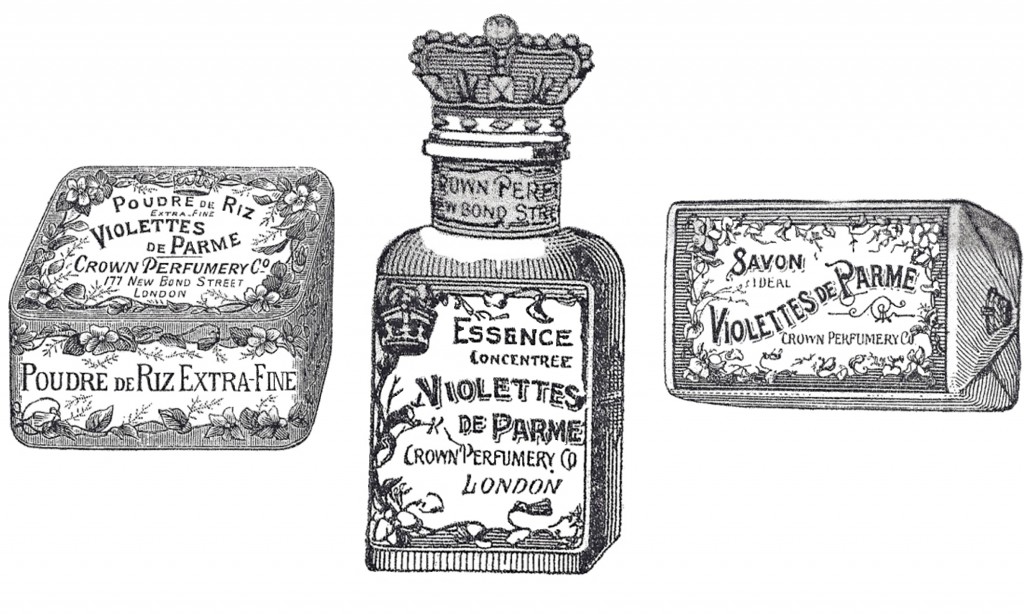
A Violettes de Parme gift set [28]
International exhibitions based on a singular theme were also held. There were international exhibitions for gardening, electricity, mining and photography. In the early 1900s, the chemical and pharmaceutical manufacturers organized their own exhibitions for “health, beauty and toilet items.” The 1901 Chemists Exhibit at Covent Garden, London, saw a “magnificent” display from The Crown Perfumery Company. A fountain filled with a luxurious Crown fragrance took center stage, enticing attendees to linger among the showcases where the perfumes were displayed. Carnatia held a favorite position that year. Impressively arranged on the shelves were silver stoppered bottles of Crown Lavender Salts.
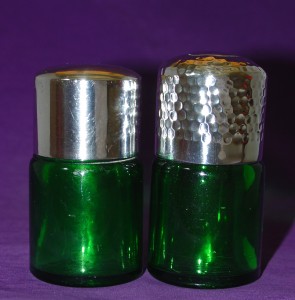
Unknown date, 1902
For the 1906 Chemists Exhibition in London, The Crown Perfumery Company had a large electric crown in the center of their very large area. A factice of Crab Apple Blossoms stood just below this crown. Jeunesse Dorée, another best seller, was available as a perfume and in related perfumed toiletry items.
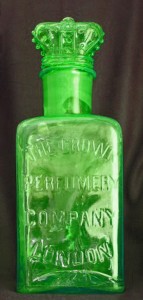
Crab Apple Blossoms Factice
21.5″ / 54.2 cm
For the Singapore/Malaya-Borneo 1922 exhibition, The Crown Perfumery Company’s octagonal showroom was draped in royal purple, white and gold. The iconic golden crown sat atop a luxurious cushion. The press announced that the company supplied H.R.H. The Prince of Wales with toilet requisites including Crown Toilet Dainties. A Grand Prize Diploma was awarded to Crown for the finest display stand and products.
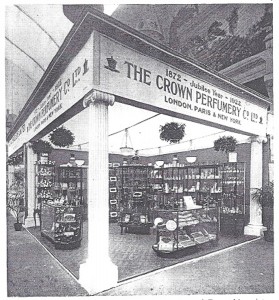
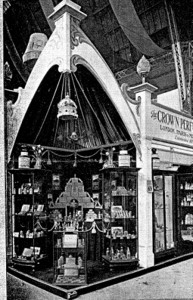
Woman’s Exhibition, Olympia, London. 1922 [29] [30]
Rather than The Crown Perfumery Company receiving an award at the 1922 Woman’s Exhibition in London, Crown presented the prize at the dance competition held during the event. The best female dancer received a casket of Crown Toilet Dainties.
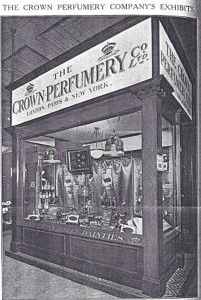
The Chemists’ Exhibition, Westminster, London 1923 [31]
A Listing of Prize Medals Awarded to
The Crown Perfumery Company
*1873. International Exhibition, London.
A Medal of Excellence was awarded to the company.
*1873. Weltausstellung, Vienna.
Crown won a Grand Prize Medal of Merit. Press reports and advertisements vary on the particular fragrance which won the award. Bengali Bouquet and Tanglewood Bouquet have both been mentioned. Also mentioned in published reports was that the entire line of Crown perfumes won the award.
*1876. United States Centennial International Exhibition, Philadelphia.
Crown was awarded two medals:
A medal for their superior essences and lavender water
Another medal for the quality, style and finish of their buffalo horn combs.
*1878. Exposition Universelle, Paris.
A bonze medal was awarded for an unknown perfume.
*1879. International Exhibition, Sydney.
A special first prize was awarded for the superiority of their exhibits, which far exceeded that of all other competitors in their categories.
*1880. Melbourne International Exhibition, Melbourne.
Crown perfumes, toilet preparations and soaps received a Second Order of Merit.
*1881. International Exhibition, Adelaide.
A prize medal was awarded for an unknown item.
*1886. Jubilee Exhibition, Adelaide.
Two first prize medals were received: one for perfumes; one for soaps.
*1888-1889. Centennial International Exhibition, Melbourne.
Two prize medals were awarded to the company:
First Order of Merit / Gold Medal for toilet soaps
Second Order of Merit / Silver Medal for perfumery.
There is also a report of Crown receiving the Medal of Excellence.
*1889. Exposition Universelle de 1889, Paris.
The Crown Perfumery Company received a Medal of Excellence and/or a silver medal for their perfumes.
*1891. International Exhibition, Tasmania.
Two prize medals were awarded:
First Award for Crab Apple Blossoms and Lavender Salts.
Special First Award for their Collective Exhibit.
*1893. World’s Columbian Exposition, Chicago.
Crown was awarded highest honors for their perfumes, toilet soaps and sachet powders.
*1906. Health, Beauty and Toilet Exhibition, London.
Crown received a Medal of Excellence at this specialized exhibition.
*1911. Festival of Empire Imperial Exhibition and Pageant of London.
Crown’s newest perfume, Iroma, received the Grand Prize at this exhibition.
*1922. Brazilian Centenary Exhibition, Rio de Janeiro.
A Grand Prize Diploma was awarded to The Crown Perfumery Company.
*1922. Malaya-Borneo Exhibition, Singapore.
A Grand Prize Diploma was awarded to Crown for the finest display stand and products.
*1922. The Woman’s Exhibition, London.
Rather than The Crown Perfumery Company receiving an award, a casket of Crown Toilet Dainties was presented to the best female dancer of the dance competition.
[26] Paul, B.H., E.M. Holmes and Passmore, F.L.S. Report on the Exhibits Connected with Materia Medica, Pharmacy, Chemical Industry, &c. in the Paris Exhibition. 1878. London: Stevens and Richardson, 1878, 116.
[27] Pall Mall Gazette (London). 6 September 1873, 5.
[28] The Pharmaceutical Era. 1 December 1893, 34.
[29] “The ‘Crown’ Perfumery Exhibit, Olympia, London, July, 1922,” The Wheel, House Magazine of W. Gossages & Sons Ltd. Autumn 1922, 29.
[30] “The Crown Perfumery Company’s Exhibits.” The Wheel, House Magazine of W. Gossages & Sons Ltd. Summer 1923, 40.
[31] “The Crown Perfumery Company’s Exhibits.” The Wheel, House Magazine of W. Gossages & Sons Ltd. Summer 1923, 41.
